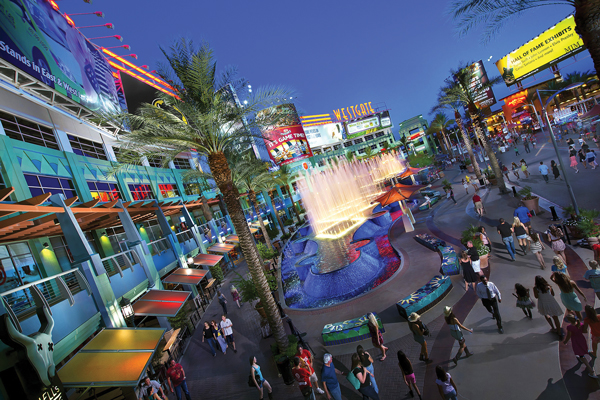Real estate executives Jeff Teetsel and Jeff Moloznik work 15 miles from each other in Phoenix. They have similar charges and challenges — make their real estate developments adjacent to stadiums and arenas economically viable year-round and not just on game days.
As with similar mixed-use developments across the nation, that can be a daunting task.
Moloznik is a vice president with RED Development, whose CityScape office, hotel and retail project in downtown Phoenix is across the street from the Phoenix Suns arena, now called Talking Stick Resort Arena, and a few blocks from the Arizona Diamondbacks’ Chase Field.
Fifteen miles away, Teetsel is development manager of the Westgate Entertainment District in suburban Glendale.
The retail and restaurant complex is next to Gila River Arena were the Arizona Coyotes play and across the street from University of Phoenix Stadium, which is home to the Arizona Cardinals, last season’s Super Bowl and this season’s College Football Playoff championship game.
 |
Arizona’s Westgate Entertainment District faced foreclosure proceedings in 2011.
Photo by: Istar Financial / Westgate |
Westgate opened in 2006 on farmland west of Phoenix. It was foreclosed on in 2011 after Arizona felt the brunt of the recession. Its lender, New York-based iStar Financial, decided to retain ownership.
The key to Westgate’s post-recession viability has been the development of a 409,000-square-foot, 90-store Tanger Outlets mall starting in 2012. That and a 20-screen AMC Theatres multiplex helped Westgate be less reliant on 10 NFL home weekends and a Coyotes franchise whose future in Glendale has been in doubt since a 2009 Chapter 11 bankruptcy filing.
“The outlets add significant critical mass to Westgate,” Teetsel said, and helped make the complex a regional destination for Phoenix’s West Valley, not just on football weekends or hockey nights.
For RED’s Moloznik, mass transit and college students have helped CityScape, which was developed on a former city park and had to recover from Wachovia pulling out of a major office lease deal.
CityScape, which opened in 2009, has been able to grab some popular and traffic-driving tenants including Starbucks, Chipotle and a Tilted Kilt restaurant as well as a sushi restaurant, a higher-end business lunch restaurant and stand-up comedy venue.
When a game or concert isn’t in play, CityScape depends on the business lunch crowd and the growth of Arizona State University’s downtown Phoenix campus. Phoenix voters approved a bond package in 2006 for ASU to build a downtown campus. The school now has more than 11,500 students in downtown Phoenix.
Moloznik said those students helped attract an Urban Outfitters and eateries including Five Guys and Jimmy John’s to downtown Phoenix, which has long struggled to get national chains or retail stores.
“It’s huge,” Moloznik said of the ASU impact. “No one recreates like young people.”
Moloznik said RED, which is also developing an 800,000-square-foot project in Dallas, is looking for programming such as concerts and a seasonal ice rink to draw traffic outside of game days.
CityScape also has benefited from the opening of a Phoenix area light rail system in 2008. The Metro system has multiple downtown stops and is used by ASU students. It’s also the reason the NFL located most Super Bowl XLIX events in downtown Phoenix. Downtown and CityScape also will host events for the college football title game and the 2017 Final Four even though the games will be played in Glendale.
While CityScape and Westgate seek additional traction in Arizona, the challenges they face have played out throughout the nation as developers look to profit from being next to ballparks, stadium and arenas.
Those projects that have not been too dependent on sports and game days have been the most successful, said Julius Blatt, a managing director with commercial real estate firm CBRE in Dallas. Blatt said the key is to give consumers something they can’t find closer to home or in the suburbs. “The appeal to the shopper, to the consumer, is to see something unique.”
Blatt said successful sports-related developments are more organic, naturally evolve and have a sense of place. He points to the Wrigleyville neighborhood next to the Chicago Cubs’ ballpark.
Marshall Brulez, a managing director and commercial real estate expert with CBRE in Detroit, said the more successful sports developments appeal to fans but also fit with the local market and surrounding neighorhood.
“There has to be some synergies there,” he said.
In some cities, a development anchored by only one team is enough. It just takes time.
Jim Mosby, a broker with commercial real estate firm Cushman & Wakefield in St. Louis, said baseball’s Cardinals and their regional fan base allow the Ballpark Village project to prosper next to Busch Stadium. The mixed-use development was delayed by the recession, changes in developers and wrangling with city officials over financing.
The $650 million downtown project opened in 2014. It was developed by the Cardinals’ owners and Baltimore-based Cordish Co. The same group developed the Kansas City Power and Light District next to the Sprint Center arena.
Mosby said the key for the viability of Ballpark Village is the Cardinals’ popularity.
“Everyone goes to at least one game,” Mosby said. He points out Cardinals attendance was 3.5 million this season and the St. Louis area’s population is 2.8 million.
He said the development’s variety of restaurants appeal to different segments of consumers. He said Ballpark Village’s next moves will be more office and multifamily developments to further boost non-ballpark traffic.
Ballpark Village has a retractable roof to encourage wintertime patronage. Mosby said the venue is now a popular venue for special events and a gathering place to watch football games.
Michael Sunnucks writes for the Phoenix Business Journal, an affiliated publication.




